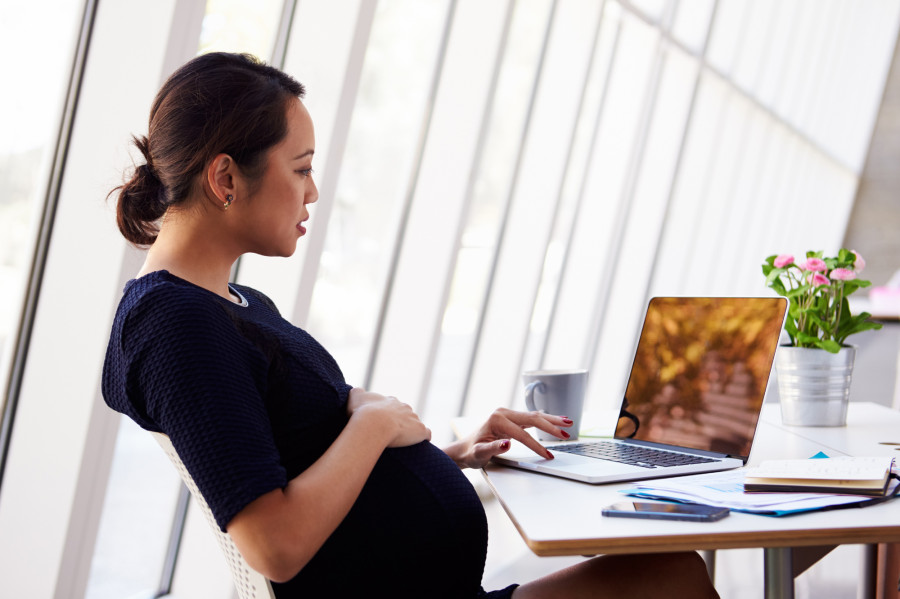National
Despite robust legal provisions, pregnant women still find it difficult to get maternity leave
The law mandates a total of 98 days of maternity leave, with 60 days fully paid, but most private employers fail to comply and women are hesitant to ask.
Elisha Shrestha
A year ago, when Ashmita Gyawali got pregnant with her first child, she had no option but to quit her job as a money collector for a local cooperative in Imadol, Lalitpur. As her company had no policies regarding maternity leave and job protection for its female employees, Gyawali quit when she was seven months pregnant.
“My husband is the sole provider now while I have some savings to support the family. I will look for a job when my baby gets a little older,” said 26-year-old Gyawali.
Gyawali should not have had to quit, as the law mandates a total of 98 days of maternity leave, with 60 days fully paid, which they can avail of before or after childbirth, according to the Labour Act 2017. Despite being enshrined in law, most private employers do not provide maternity leave to their employees. When they get pregnant, women often have to quit their jobs as they are unable to come in to work, especially in the later stages of their pregnancy.
Nearly 70 percent of organisations in the country, mostly private institutions, either do not provide any maternity leave or just a month or two, according to the Forum for Women, Law and Development, an organisation that works for women’s rights in Nepal.
Women have the right to file a court case against their employers if they don’t receive maternity benefits, but instead, most working women end up quitting their jobs, said advocate Nabin K Shrestha, programme manager at the forum.
“From different workshops on maternity rights, we’ve found that 80 percent of women working in the informal sector are completely ignorant about the existence of maternity leave,” said Shrestha. “Even those women working in the formal sector were hesitant to speak out against their employers for not providing them with leave during pregnancy and after childbirth.”
In 2018, the government adopted the Safe Motherhood and Reproductive Health Rights Act, which secures legal protection for paid maternity leave, prohibits discrimination, and ensures job security during pregnancy and after childbirth. The Social Security Fund covers 38 out of the 98 days of maternity leave while the remaining 60 will have to be covered by the employers, according to Kapil Gyawali, executive director of the fund.
These robust legal provisions, however, still don’t translate into concrete actions. In August 2019, the Tyud Secondary School in Asan faced legal action after a teacher was denied maternity leave even in her ninth month. Although the National Women Commission had directed Principal Surendra KC to provide maternity leave after a teacher filed a complaint, she was made to come to school even while she was in labour pains, according to an eKantipur report. The principal was subsequently arrested by the police after the teacher lost her baby.
According to the Nepal Labour Force Survey 2017-18, out of a total 11.58 million working-age women, aged 15 and above, only 2.6 million are employed, and labour scholars believe that this has a lot to do with a working environment that does not take women’s needs into account.
“Lack of women-friendly environments and lack of daycare centres in the workplace can be two factors that are leading to many qualified women staying away from formal jobs,” said Saru Shrestha Joshi, a gender and migration consultant for a number of organisations.
The Labour Act 1991 and the Labour Rules 1994 had introduced gender-friendly work environments where organisations were mandated to provide a childcare centre if they had 50 or more women employees. But, the Labour Act 2017 removed those provisions.
Since men lead most organisations, they are often indifferent to issues related to women, including maternity rights, according to Meera Dhungana, president of the forum.
Richa, who worked in a five-star hotel in Kathmandu as an assistant manager, said that her male bosses were inconsiderate when she informed them of her pregnancy.
“Although I was eight months pregnant, they made me cover a nine-hour shift several times despite my requests that they consider my situation,” said 29-year-old Richa, who asked that she only be identified by her first name.
The last straw for Richa was when she had to travel back and forth to breastfeed her baby during her lunch break.
“I got three months of maternity leave after delivery, but I realised that three months is not enough to fully recover from giving birth and to bond with the baby,” said Richa, who eventually quit her job.
Although the Ministry of Health had proposed increasing the duration of maternity leave to six months, the forum’s Shrestha said that the proposal wasn’t approved by a majority of members responsible for formulating the bill related to the Safe Motherhood and Reproductive Health Rights Act. They cited the negative impacts that six months of maternity leave could have on female employment, said Shrestha.
According to Shrestha, most organisations still prefer hiring males since women require paid maternity leave, childcare rooms and in some cases, an employee to fill in during the female employee’s absence.
“Six months of maternity leave is a bad idea in the context of Nepal where the number of female employees is already low,” said Shrestha, who was one of the members to formulate bills for Safe Motherhood and Reproductive Health Rights Act 2018.
But he believes that the 15 days of paternity leave, ensured by the Labour Act, is adequate as most men don’t contribute to household activities.
However, Sanjita Timsina, programme coordinator at the Women’s Rehabilitation Centre, another women’s rights organisation, believes that an increase in paternity leave could actually help women.
“In a patriarchal society like ours, mothers are expected to be solely responsible for raising children,” said Timsina. “While few employers provide flexible maternity leave and women-friendly work environments, the lack of a partner’s presence during pregnancy and after childbirth can further lead women to quit their jobs.”




 14.83°C Kathmandu
14.83°C Kathmandu (1).jpg)










%20(1).jpg&w=300&height=200)




